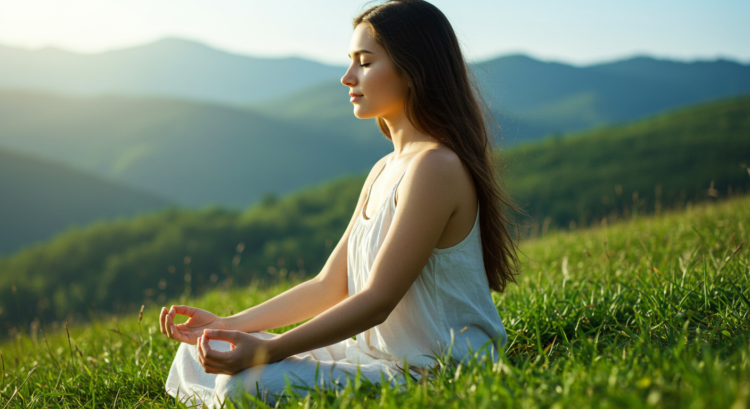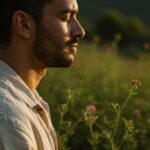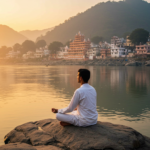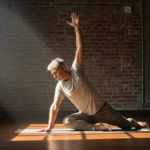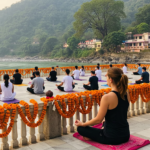Answering the Call of Silence
There comes a time in the relentless hum of modern life when the soul craves quiet. Not just the absence of noise, but a deeper stillness, a space to reconnect with something essential that gets lost in the daily shuffle. For me, that craving intensified as Easter approached, a time traditionally marked by reflection, yet often swallowed by routine. I felt a pull, a yearning to step away, not just from the digital deluge and endless to-do lists, but into a space where I could truly listen – to myself, to something larger. It was in this state of seeking that I stumbled upon the Hridaya Yoga retreat in France, specifically their 6-Day Easter Silent Meditation Retreat. The description resonated immediately – silence, meditation, the promise of diving deep within. It felt like an answer to a question my heart had been whispering for a long time.
What truly captivated me, however, was the unique blend promised by this particular retreat. It wasn’t just about generic mindfulness or a simple digital detox, valuable as those are. This experience offered something more specific, a synthesis I hadn’t encountered before. It centered around Hridaya Yoga’s profound focus on the Spiritual Heart, a concept pointing towards our deepest essence, our true Self. But uniquely, especially for an Easter retreat, it proposed exploring this through the lens of Advaita Vedanta – the ancient Indian philosophy of non-duality – and Bhakti Yoga, the path of love and devotion. And woven into this tapestry were contemplations on the teachings and life of Jesus, viewed not through dogma, but through this universal perspective of oneness, love, and surrender. It suggested a path that transcended traditional boundaries, appealing to a yearning for universal truths, a way to explore the heart’s wisdom where different mystical streams might converge. This wasn’t presented as a standard religious observance, nor just another yoga holiday, but as a profound invitation to explore compassion and the nature of being, drawing wisdom from multiple wells. The prospect felt both challenging and incredibly enriching, promising a spiritual depth perfectly attuned to the reflective Easter season.
The final piece that sealed my decision was the location. The retreat was nestled deep in the French countryside, in the Auvergne-Rhône-Alpes region, specifically at a place called Château de Longeval. Images conjured a sense of tranquility, of rolling hills and quiet forests far removed from urban clamor. The venue itself, a historic château, whispered of time slowed down, of a space inherently conducive to introspection. It felt like the perfect external setting to facilitate the profound internal journey I hoped to undertake. The promise was clear: a journey into stillness, held within the gentle embrace of rural France, allowing the heart space to finally speak, and perhaps, be heard.
Journey into the Beaujolais Hills: Finding Château de Longeval
The journey itself felt like the beginning of the unwinding process. Arriving in Lyon, a city vibrant with history and energy, I felt the familiar buzz of travel. But as the train carried me outwards, towards the Beaujolais region, the landscape began to shift. The urban gave way to rolling hills, vineyards unfurling in neat rows under the spring sky, though as we ventured deeper, the scenery took on the wilder, greener character of the ‘Beaujolais Vert’. Towns became villages, roads narrowed, and the air itself seemed to carry a different quality – cleaner, quieter, scented with earth and growing things. With each passing kilometer, I felt the layers of city life peeling away, replaced by a growing sense of anticipation, a quiet excitement for the stillness that awaited. The trip from Lyon took about an hour, but it felt like transitioning between worlds.
Turning off the main road, the approach to Saint-Just-d’Avray and then Château de Longeval itself was like stepping further back in time. The village felt peaceful, quintessentially French. Then, winding along the Chemin de Longeval, the Château emerged, not with imposing grandeur, but with a quiet dignity. Dating back to the 17th century, the building possessed a palpable sense of history, nestled within the heart of the Longeval Forest. It sits on over seven hectares of land, offering stunning views across the Azergues Valley – a panorama of green hills and quiet woods stretching out below. The immediate impression was one of profound peace, a sanctuary truly removed from the noise and rush of the everyday world. Numerous hiking trails beckoned from the surrounding woods, promising moments of solitary connection with nature. This was clearly a place chosen for its tranquility, a place where the external environment naturally encouraged an inward turn. The Château de Longeval retreat experience had truly begun, the setting itself whispering an invitation to slow down and listen. The area’s classification as a Zone of Natural Ecological Interest (ZNIEFF) further underscored the richness and preserved quality of the surrounding nature, adding another layer to the sense of being held in a special, protected space.
Check-in, scheduled from 2 pm, was handled with a gentle efficiency that seemed perfectly attuned to the retreat’s purpose. The welcome was warm yet subdued, a quiet acknowledgement that we were all here for a shared, introspective purpose. There was an immediate sense of entering a space dedicated to practice. I found my way to my accommodation – I had opted for a shared twin room. The options ranged from dormitories to private twin and double rooms, catering to different budgets. As expected, and as is common in many retreat centers focused on inner work, the room was simple, clean, and functional. No unnecessary frills, just a comfortable bed, provided bedding and towels, and a sense of uncluttered space. Most rooms, including mine, shared bathroom facilities, reinforcing the understanding that this wasn’t about luxury amenities but about supporting the core experience – the meditation, the silence, the inner exploration. The focus was clearly internal. Exploring briefly before the official start, I noted the communal dining area, the dedicated yoga studios – four of them, I later learned, of varying sizes – and the beautiful gardens surrounding the château. Even the availability of Wi-Fi felt like a minor detail, soon to be irrelevant in the embrace of silence. Everything felt intentionally designed to minimize distraction and support the journey ahead.
VISIT THE RETREAT WEBSITE FOR MORE
INFORMATION & PRICES
Entering the Stillness: The Embrace of Noble Silence
The transition into silence, or Mauna as it’s known in the yogic tradition, happened gently, almost imperceptibly, after the first evening meal and an introductory session outlining the guidelines. One moment there was the low murmur of pre-retreat chatter, the next, a profound quiet settled over the group. The rules were simple, yet demanding: no speaking, of course, but also minimizing gestures, avoiding direct eye contact, and crucially, switching off all devices – phones, laptops, even books and personal journals, though some reflective writing might be encouraged at other retreats, here the focus was purely inward. My initial reaction was a mix of relief and a strange, fluttering anxiety. Relief at shedding the obligation to interact, to perform, to make small talk. Anxiety about… what? The unknown? Being alone with my own thoughts for six days? The sudden absence of verbal communication made the ambient sounds incredibly loud – the creak of floorboards, the distant call of a bird outside, the clink of cutlery during meals. It felt utterly strange to be surrounded by people, sharing this space, yet existing in separate, silent bubbles.
The silence itself quickly revealed its multifaceted nature. It wasn’t merely an absence of noise; it felt like a presence, a container holding us all. Externally, the sounds of the Château and its surroundings became amplified. I started noticing the subtle symphony of the Longeval Forest – the rustle of leaves, the specific songs of different birds, the sigh of the wind through the pines. Inside the historic building, every footstep echoed, every cough seemed magnified. This external quiet, however, served only to highlight the internal landscape. As many who undertake silent retreats discover, the initial phase can unleash a torrent of mental chatter. My mind, freed from its usual external anchors, seemed to race, darting between past regrets and future worries, planning, analyzing, commenting – a relentless inner monologue suddenly thrown into sharp relief against the backdrop of silence. It was a stark reminder that the loudest noise often comes from within.
Yet, paradoxically, this shared silence fostered a unique kind of connection. There was an unspoken understanding, a sense of being in this together, navigating the same waters, even without exchanging a single word. The relief I’d initially felt at not having to engage socially deepened. There was no need to curate a persona, no subtle adjustments for another’s gaze. It allowed for an unedited rawness, a chance to simply be, observed only by oneself and the quiet presence of others doing the same. Far from feeling isolating, after the initial adjustment, this communal silence felt profoundly supportive. It was like being held in a collective field of intention, each person’s commitment to the practice reinforcing the others’. This shared container, this experience of being ‘alone together’, felt crucial. It offered a sense of safety and solidarity that made the prospect of confronting the inner world less daunting than true solitary retreat might have been. We were on individual journeys, yet held within a common, silent embrace.
Exploring the Spiritual Heart: Hridaya Teachings Unveiled
Central to the entire Hridaya Yoga retreat experience is the concept of the Spiritual Heart, or Hridaya. During the teaching sessions, this was unfolded not as a mere metaphor, but as the very core of our being. It was explained, conversationally yet profoundly, that Hridaya refers not to the physical pump in our chest, nor simply to our emotions, but to something far more fundamental: our essential nature, the Supreme Self, known in Sanskrit as atman. It’s the unchanging background of awareness, the ultimate Subject, the pure “I” that witnesses all our thoughts, feelings, and experiences without being caught up in them. It’s the source of true peace, boundless joy, and inherent freedom that lies beneath the surface of our personality. We were guided to bring our attention to a specific area – the center of the chest, slightly to the right, a location pointed to by the great sage Ramana Maharshi as a potent portal to this inner reality. This wasn’t about intellectual understanding alone, but about cultivating a felt sense of this deep, inner core.
The retreat masterfully wove the Easter theme into this exploration of the Heart. The focus wasn’t on traditional dogma, but on the universal messages within Jesus’s life and teachings, viewed through the illuminating lenses of non-duality (Advaita Vedanta) and the path of love (Bhakti Yoga). We contemplated aspects like the Beatitudes, Jesus’s life interpreted as that of a Bodhisattva (an enlightened being dedicated to the liberation of others), and the profound meaning of resurrection as a symbol of awakening to our true, eternal nature. These explorations were seamlessly integrated with the core non-dual understanding that, ultimately, all is One – a single, indivisible Consciousness manifesting as everything. Bhakti yoga provided the devotional flavour, emphasizing the path of love, surrender, and opening the heart to compassion and loving-kindness as essential aspects of this journey. We were introduced to spanda, the Sacred Tremor of the Heart – described as a subtle, intimate vibration felt in the chest area during deep quietude, the most direct, tangible experience of the Spiritual Heart’s presence, the very pulse of consciousness itself. This blend of Jnana (wisdom/non-duality) and Bhakti (love/devotion) felt incredibly potent, offering both clarity for the mind and warmth for the heart, making the abstract concepts feel embodied and accessible through direct feeling and surrender.
The primary tool for this exploration was, of course, Hridaya Meditation. We gathered four times a day in the dedicated practice halls for guided sessions. The technique itself is beautifully simple yet profound, comprising three main elements practiced simultaneously. First, maintaining awareness of the Heart Center – that space in the chest, slightly to the right – as the anchor point for our attention. Second, becoming aware of the natural, short pauses that occur after each inhalation and each exhalation. These tiny gaps in the breath cycle were presented as doorways into the underlying stillness, the silence between thoughts. Third, incorporating Self-Inquiry, primarily through the question “Who am I?”. This wasn’t posed as an intellectual riddle seeking a verbal answer, but as an open-ended investigation, a way to turn the attention back upon its source, dissolving identification with the limited ego and opening towards the vastness of the true Self. This method, deeply inspired by Ramana Maharshi, felt like a gentle yet persistent invitation to drop beneath the surface chatter of the mind, to rest in the quiet presence of the Heart, cultivating a state of Witness Consciousness – observing thoughts and sensations arise and pass without judgment. The emphasis was always on revelation, on uncovering what is already present within us, rather than striving to achieve some future state.
Complementing the stillness of sitting meditation was the daily 90-minute Hridaya Hatha Yoga session. This wasn’t the fast-paced, fitness-oriented yoga common in many studios. Instead, it was a slow, deeply meditative practice. Poses (asanas) were held for longer periods, allowing time to truly feel the sensations in the body, observe the breath, and cultivate inner awareness. The focus wasn’t on achieving perfect alignment or pushing physical limits, but on using the postures as tools for inner exploration, as moving meditations. We were encouraged to approach the practice with an attitude of devotion and surrender, allowing the body to open naturally rather than forcing it with ego-driven will. Each session felt like an opportunity to bring the principles of Hridaya – awareness, stillness, Heart-focus – into movement, exploring the interplay of energy and consciousness within the physical form. This gentle, mindful approach not only helped to ease the physical stiffness that can arise from long periods of sitting but also beautifully reinforced the core meditative themes, making the yoga practice feel like a seamless extension of the journey into the Spiritual Heart, rather than a separate activity. It was about ‘being’ in the pose, not just ‘doing’ it.
VISIT THE RETREAT WEBSITE FOR MORE
INFORMATION & PRICES
Wisdom and Presence: Guidance from Antoaneta Gotea
Guiding us through this profound inner landscape was Antoaneta Gotea, a senior Hridaya teacher whose presence felt like a calm anchor throughout the retreat. Her Romanian roots and long dedication to the yogic path – practicing since she was 21 and studying deeply in traditions like Raja Yoga, Mahavidya Yoga, and Kashmir Shaivism – were evident not just in her biography but in the quiet depth she brought to the teachings. Learning about her extensive personal retreat experience, including challenging solitary and dark retreats, instilled a sense of confidence; here was someone who had navigated these inner territories herself and could offer guidance grounded in authentic experience. Her background also includes embracing the compassion teachings of Tibetan Buddhism and co-founding the Hridaya Teacher Training program, highlighting a breadth and depth of understanding that enriched her guidance. Her reported experience in Tantra and leading women’s groups also hinted at a capacity to hold space for diverse aspects of the human experience.
During the daily teaching sessions and Q&A periods, Antoaneta had a remarkable ability to translate complex spiritual concepts – the subtleties of non-duality, the nature of the Spiritual Heart, the integrated perspective on Jesus’s teachings – into accessible, relatable language. Her delivery was calm, compassionate, and infused with a gentle wisdom that resonated deeply. Questions, submitted in writing to maintain the integrity of the silence, were addressed with clarity and sensitivity. What stood out was her skill in weaving together insights from various traditions – Advaita Vedanta, Sufism, Christianity, Buddhism, Tantra – demonstrating how these seemingly different paths ultimately point towards the same ineffable reality of the Heart. It wasn’t about doctrine, but about direct experience. A key feeling I took away from her guidance was the importance of gentle persistence and self-compassion on the path. Her deep personal practice clearly informed her teaching, allowing her to offer nuanced support that felt both authoritative and deeply human, crucial for navigating the sometimes intense terrain of a silent meditation retreat France.
The Sacred Rhythm: A Day in Silent Contemplation
Life within the retreat quickly settled into a steady, supportive rhythm. The daily schedule provided a clear structure, a container holding the space for deep inner work. Each day, from Wednesday through Saturday, unfolded with a predictable flow: waking early for the 7 am to 9 am session combining Hridaya Hatha Yoga and meditation, followed by a silent breakfast. The morning continued with teachings and more meditation from 10 am until 1 pm lunch. The afternoon offered a precious window from 1 pm to 4 pm for rest, personal contemplation, or perhaps a quiet walk in the beautiful grounds – a chance to digest the morning’s experiences. Then, from 4 pm to 6:30 pm, we gathered again for Q&A, further teachings, and meditation, leading into a simple dinner around 6:30 pm. The evening, from 7 pm to 10 pm, was another period designated for rest and contemplation before retiring, allowing the day’s experiences to settle in the quietude. This consistent rhythm, alternating periods of guided practice, instruction, nourishment, and personal space, felt incredibly grounding. It removed the need for decision-making about mundane matters, freeing up mental energy to focus entirely on the inward journey.
Meals became rituals in themselves. Served in the communal dining area, the food was simple, nourishing, and delicious – primarily vegan, reflecting an awareness of ahimsa (non-harming), though some dairy items were available on the side. The kitchen emphasized fresh, organic, and locally sourced ingredients whenever possible, and you could taste the care that went into preparation. Eating in complete silence was a revelation. Without conversation to distract, awareness naturally turned to the food itself – the textures, the subtle flavors, the act of chewing and swallowing. It became a practice in mindfulness, a deep appreciation for the nourishment being received. Simple acts like sipping water, or preparing a cup of tea with the provided hot water (bringing your own tea bags was recommended), took on a quality of focused presence.
The practice sessions took place in the Château’s dedicated halls. Having four distinct spaces of varying sizes meant groups could be accommodated comfortably, maintaining an atmosphere conducive to deep focus. Meditating and practicing yoga together in these quiet, sunlit rooms, surrounded by others engaged in the same inner work, created a powerful collective energy. During the rest periods, the surrounding nature offered a gentle embrace. Stepping outside into the gardens or venturing onto one of the nearby hiking trails through the Longeval Forest provided moments of grounding and connection with the earth. The sheer beauty of the Auvergne landscape – the rolling hills, the quiet woods, the expansive views – felt deeply supportive, a constant reminder of a larger, peaceful presence. This spiritual retreat Auvergne setting wasn’t just a backdrop; it was an active participant in the healing process. The combination of the structured schedule, the simple living, the dedicated practice spaces, and the tranquil natural environment worked synergistically, creating a potent container designed to minimize external noise and maximize the potential for turning inwards and discovering the peace of the Heart. Every element felt purposeful, geared towards facilitating this profound immersion.
Navigating the Inner World: Reflections and Revelations
Of course, the journey inward wasn’t always serene. The silence, while ultimately liberating, initially acted like a mirror, reflecting the restless nature of my own mind. As expected, and as is common on such retreats, challenges arose. There were periods of intense restlessness, where sitting still felt almost impossible. Boredom sometimes surfaced, the mind craving stimulation, any stimulation. Physical discomfort, particularly during the longer meditation sits, made its presence known – an aching back, protesting knees. And then there were the thought loops – recurring worries, fragments of conversations, endless planning scenarios playing out on repeat. Doubts crept in: Was I doing this right? Was anything actually happening? Moments of impatience and even flickers of anger at my own inability to simply be still were part of the landscape. Yet, the teachings reminded us to view these not as failures or obstacles, but as part of the process itself – a necessary “purification,” as Hridaya calls it, where the accumulated dross of the conditioned mind comes to the surface to be seen and released.
VISIT THE RETREAT WEBSITE FOR MORE
INFORMATION & PRICES
Alongside the mental chatter, the silence also created space for deeper emotions to emerge. Things long buried or ignored in the busyness of daily life began to surface. Waves of sadness washed over me at unexpected moments, sometimes accompanied by tears that seemed to come from nowhere. Old griefs, unresolved frustrations, even pockets of anger – they all presented themselves, demanding acknowledgement. But within the safe, non-judgmental container of the retreat, and without the usual distractions or social pressures, there was finally space to simply feel them without needing to suppress or analyze them away. This emotional release, while sometimes uncomfortable, felt profoundly cathartic, like clearing out old debris to make space for something new. It wasn’t just about difficult emotions, either; moments of unexpected joy, gratitude, and a deep sense of tenderness also bubbled up, raw and unfiltered. It was a powerful reminder of the richness and complexity of the inner world, often hidden beneath layers of conditioning. This felt like the heart truly opening, moving beyond the ego’s defenses.
And amidst the challenges and the emotional tides, there were moments of pure grace. Glimmers of what the teachings pointed towards. Sometimes, a profound sense of peace would descend, a stillness so deep it felt like sinking into an infinite, calm ocean. Thoughts would still arise, but they were seen clearly, like birds flying across a vast sky, no longer pulling me away. Clarity emerged – insights into patterns of behavior, a sudden understanding of a long-held question, a sense of perspective on life’s challenges. There was a heightened awareness, a vibrant presence in the here and now. The taste of the simple food became exquisite, the colours of the forest seemed more vivid, the warmth of the sun on my skin felt like a blessing. At times, I felt a subtle vibration in my chest, a gentle warmth – perhaps the spanda, the Sacred Tremor the teachings described, a felt sense of the Heart’s aliveness. These were not constant states, but precious glimpses, moments where the clouds parted, revealing the clear sky of my true nature. These breakthroughs, often emerging right after navigating a period of difficulty, were the undeniable fruit of the silent meditation retreat France experience, validating the entire process. The journey through the inner turbulence was precisely what allowed these moments of profound peace and connection to dawn.
Emerging Renewed: Bringing the Stillness Home
The retreat culminated on Easter Sunday, following a slightly different schedule designed to gently transition us back towards the world. The morning held final sessions of teachings and meditation, allowing for a deepening integration of the week’s experiences. Breakfast was followed by a final Q&A and meditation period. Then came the closing lunch at 1 pm. The reintroduction of speech, often guided to be mindful and intentional, felt both strange and connecting. Hearing voices again after days of silence was initially jarring, but sharing the final meal together fostered a warm sense of community, a shared acknowledgement of the journey we had undertaken side-by-side, yet profoundly alone. There was a quiet joy, a shared understanding that transcended the need for extensive conversation.
Leaving the serene bubble of the Château de Longeval retreat and stepping back into the rhythm of everyday life was a transition in itself. The immediate after-effects were palpable: a lingering sense of deep calm, a clarity of mind that felt sharp and focused, and an openness in the heart. My senses felt heightened, the world seemed brighter, sounds clearer. There was a feeling of carrying the stillness within me, like an internal anchor amidst the returning flow of external stimuli. The profound peace experienced during the deepest moments of the retreat might not be sustainable in the face of daily demands, as experience often shows, but something fundamental felt shifted.
The true value of such an immersive experience lies in its potential for lasting integration. The insights gained, the direct felt sense of the Spiritual Heart, the tools learned – these don’t necessarily vanish when the retreat ends. Hridaya Yoga emphasizes applying this vision of oneness and Heart-awareness in the midst of everyday life, and the retreat provided a powerful foundation for doing so. While the intensity of the peace might ebb and flow, the practice itself cultivates resilience. The ability to observe thoughts and emotions without immediate reaction, the capacity to return to the breath and the Heart-space, the increased self-awareness, and the blossoming of compassion – these are qualities that endure and deepen with continued practice. The retreat felt less like an escape and more like a profound recalibration, equipping me with inner resources to navigate life with greater presence, wisdom, and kindness.
Is This Journey for You? Considering the Hridaya Silent Retreat
So, who is this kind of deep dive for? The beauty of the Hridaya approach is its accessibility. This retreat, like their general programs, is explicitly open to everyone, regardless of previous yoga or meditation experience. Beginners are welcomed alongside seasoned practitioners, and the teachings are structured to meet people where they are. However, while no prior skill is required, a certain readiness is essential. It calls for a genuine curiosity, an aspiration to explore your inner world, and a willingness to engage with the profound questions of existence. It’s particularly resonant for those drawn to the specific teachings of Hridaya Yoga – the focus on the Spiritual Heart, the non-dual perspective inspired by Advaita Vedanta and sages like Ramana Maharshi, and the integration of heart-opening Bhakti practices.
Naturally, prospective participants should feel comfortable with, or at least open to, the retreat’s unique Easter theme, which integrates contemplation of Jesus’s teachings within this broader Eastern philosophical framework. It offers a bridge for some, but might not align with everyone’s path. If you’re specifically seeking a deep silent meditation retreat France, held within a supportive community and surrounded by the profound peace of nature, this spiritual retreat Auvergne offers an exceptional container. The combination of structured guidance, dedicated practice time, and the serene environment makes it a powerful setting for transformation.
Before booking, it’s important to consider the commitment involved. Six days of noble silence is a significant undertaking. It requires a willingness to sit with discomfort – physical, mental, and emotional – and to trust the process. Reading the retreat guidelines provided by Hridaya Yoga France, as they encourage, is a crucial step in assessing personal readiness. Practicalities also matter. Be prepared for simple, shared accommodation (though private options exist at a higher cost) and wholesome, primarily vegan meals. The price varies depending on your room choice, ranging from around US$442 for a dorm spot to US$648 for a private twin room (with shared bath), reflecting the focus on accessibility rather than luxury. Ultimately, this retreat is for those who hear the call of silence and feel a resonance with the path of the Heart, ready to embark on a journey that promises not necessarily ease, but profound depth and the potential for lasting inner change. It requires both an alignment with the specific Hridaya philosophy and the inner resilience to embrace the quiet intensity of the silent format.
Conclusion: Echoes of the Heart
My time at the 6-Day Hridaya Easter Silent Meditation Retreat was more than just a getaway; it was a profound immersion, a journey into the quiet depths of my own being. It delivered on its promise of stillness, but offered so much more: a unique and potent blend of Hridaya meditation focused on the Spiritual Heart, gentle yet deep Hatha Yoga, illuminating non-dual teachings, and a thoughtful integration of Easter’s reflective spirit through a universal lens. It was an experience that challenged, nourished, and ultimately, transformed.
The power of sustained silence, held within the supportive container of the Château de Longeval retreat, cannot be overstated. Coupled with the clarity and compassion of Antoaneta Gotea’s guidance and the profound wisdom embedded in the Hridaya practices, it created an environment ripe for self-discovery. The serene beauty of the Auvergne countryside provided a constant, gentle reminder of peace and interconnectedness, grounding the intense inner work in the embrace of nature. This wasn’t just a retreat; it was a carefully orchestrated symphony of elements designed to quiet the mind and open the heart.
Returning to the world, the silence doesn’t vanish completely. It leaves echoes, a resonance deep within. The peace discovered may fluctuate, but the connection to the Heart, the awareness cultivated, feels like a lasting gift. The Hridaya Yoga retreat experience is a reminder that beneath the noise of everyday life, there is a sanctuary of stillness accessible to us all. It’s a journey inward that, while demanding, is profoundly worthwhile, leaving you with a clearer mind, a more open heart, and a deeper understanding of the mystery and beauty of your own being.

